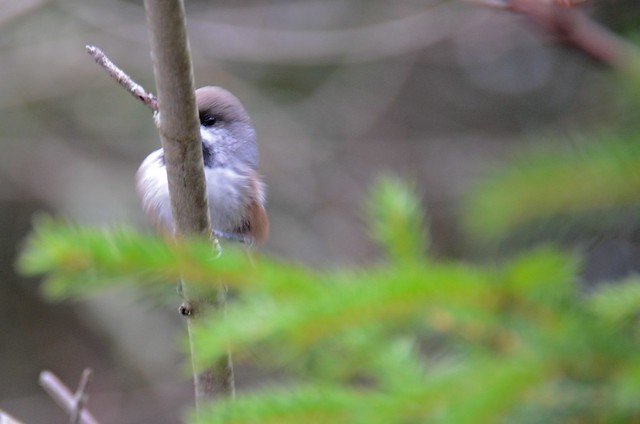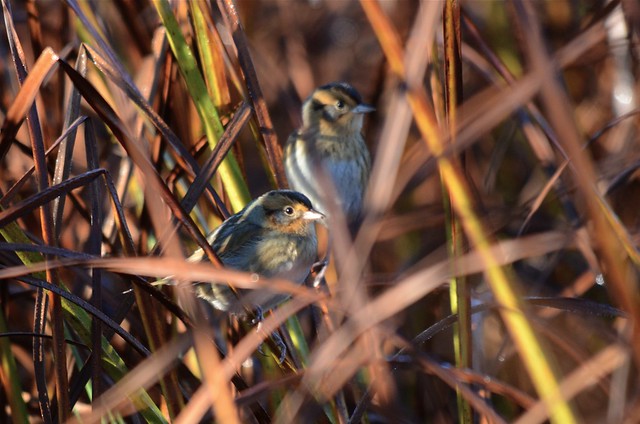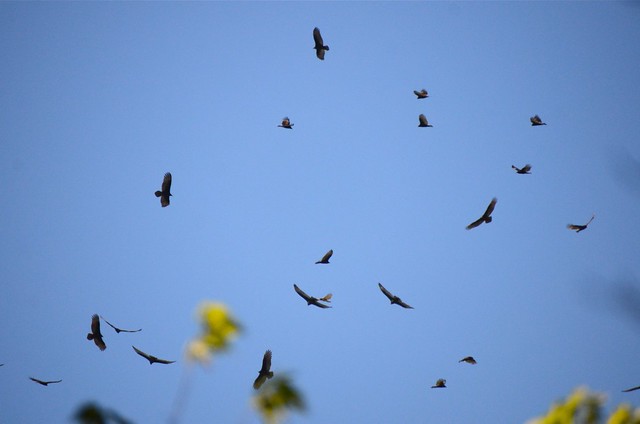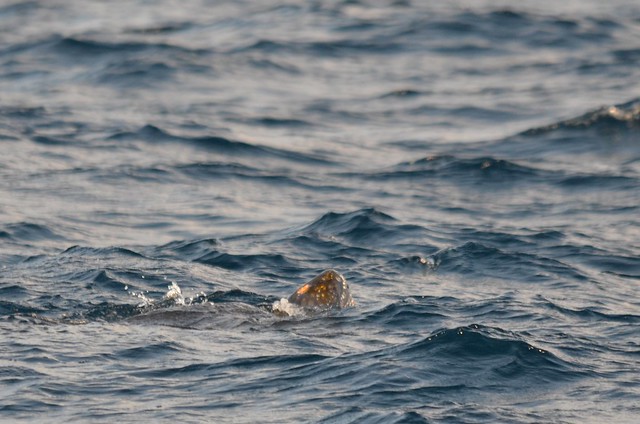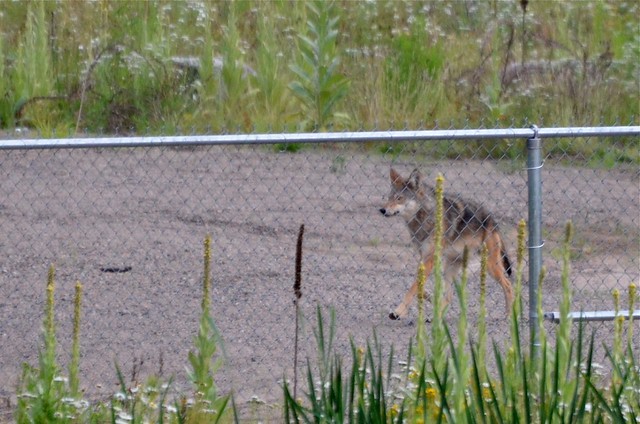Algonquin ha entrado en el invierno esta semana. Sólo los migrantes más resistentes y aves residentes permanecen, y aunque de gran belleza, el Parque se ha convertido en un lugar desolado y frío, hostil a la mayoría de las formas de vida.
Indeed a visitor who undertakes a casual day trip into the park now will find it almost devoid of visible animal life, save for a few hardy birds and a mammal if they're lucky enough.
De hecho, un visitante que emprende un viaje ocasional en el parque ahora encontrará casi desprovisto de vida animal visible, salvo algunas aves resistentes y un mamífero, si tienen la suerte.
It will be understandable then for them to assume that is truthfully the way things are, and nature has "gone to sleep" for another season. This, however, is far from the truth. There is a lot of life happening right now. The trick is knowing where.
Será comprensible entonces que ellos suponen que es verdad como están las cosas, y la naturaleza ha "dormido" por una temporada más. Esto, sin embargo, está lejos de la verdad. Hay un montón de vida sucediendo ahora mismo. El truco es saber dónde.
Lake Opeongo is the largest lake in the park, covering 5.8 square kilometres. It sits on the Canadian Shield - a solid, nutrient poor bedrock of granite and gneiss. As a result, its waters are very poor and anything that lives in it must "dig deep" in order to survive.
Lake Opeongo es el lago más grande en el parque, que cubre 5,8 kilometros cuadrados. Se sienta en el Escudo Canadiense - un sólido cimiento pobres en nutrientes de granito y gneis. Como resultado, sus aguas son muy pobres y todo lo que vive en ella deben "profundizar" con el fin de sobrevivir.
If one were to go out in a boat on Opeongo at this time of year, one would wonder exactly how ANYTHING can survive here.
Si uno fuera a salir en un bote en Opeongo en esta época del año, uno podría preguntarse exactamente cómo CUALQUIER cosa puede sobrevivir aquí.
Under the surface of Opeongo, the waters have been steadily cooling. Though still much warmer than the air temperature, as the thermometer drops, things that have been spending their summer in the frigid waters of the depths start to rise, in numbers.
Bajo la superficie de Opeongo, las aguas han ido en constante enfriamiento. Aunque aún mucho más caliente que la temperatura del aire, a medida que baja el termómetro, las cosas que han estado pasando su verano en las gélidas aguas de las profundidades comienzan a aumentar, en los números.
The magic number is somewhere near 11°C. This usually happens in the last two weeks of October.
El número mágico es un lugar cerca de 11 ° C. Esto suele suceder en las dos últimas semanas de octubre.
Lake Trout have spent their summer in the depths of the lake, feeding on zooplankton and any baitfish like Perch or Cisco that ventures down there. They cannot tolerate high water temperatures, and because Algonquin sits on a so-called "dome", much of our lakes are excellent habitat for these fish, and indeed we have the highest density of Lake Trout lakes anywhere in Ontario.
Trucha de lago han pasado el verano en las profundidades del lago, se alimentan de zooplancton y cualquier carnada como la Perca o Cisco que se aventura por allí. No pueden tolerar altas temperaturas del agua, y porque Algonquin se encuentra en una llamada "cúpula", gran parte de nuestros lagos son un excelente hábitat para estos peces, y de hecho tenemos la mayor densidad de lagos de trucha apropiadas en cualquier lugar en Ontario.
As Autumn approaches, most trout over six years old cease feeding entirely. Their greens become more intense and an orange cast develops on their fins. The females begin to swell with roe and the males likewise with milt. They are ready to spawn.
Cuando se acerca el otoño, la mayoría de las truchas de más de seis años de edad dejan de alimentarse por completo. Sus hojas se vuelven más intensas y un elenco naranja desarrolla en sus aletas. Las hembras comienzan a hincharse con las huevas y los machos lo mismo con esperma. Ellos están listos para desovar.
When the water is sufficiently cold, under the cover of darkness, these fish appear where they haven't been since early spring - the shallows.
Cuando el agua está lo suficientemente frío, bajo el amparo de la oscuridad, estos peces aparecen en la que no lo hayan sido desde principios de la primavera - las aguas poco profundas.
They are looking for cobblestone-sized rocks sitting in 2-5 metres of water. There are several such sites in Opeongo, and trout use these shoals generation after generation.
Ellos están buscando pequeñas rocas que se sientan en 2-5 metros de agua. Hay varios sitios en Opeongo, y la trucha utilizan estos bajíos generación tras generación.
Once the female selects a suitable site, she assumes spawning posture and is immediately attended by one or more males. She begins to release her eggs onto the spawning bed as the males simultaneously release their milt. Bigger trout produce more eggs - it is the large females that drive the population. The eggs eventually will fall through the cracks in the rocks and will stay there until Spring.
Una vez que la hembra escoge un lugar adecuado, se asume la postura de desove y es atendido inmediatamente por uno o más machos. Ella comienza a liberar sus huevos en la cama de desove como los machos liberan al mismo tiempo su esperma. Truchas más grandes producen más huevos - es las grandes hembras que impulsan la población. Los huevos eventualmente caerán por las grietas de las rocas y se quedará allí hasta la primavera.
This is not an easy natural phenomenon to observe, as the conditions under which this takes place are a bit difficult for the average person, but I was lucky enough to be able to go out with the Harkness Laboratory of Fisheries Research for the annual Lake Trout gillnetting season. They have been doing research and tagging Lake Trout on Opeongo since 1936 - the oldest running study on any fish in the world.
Este no es un fenómeno natural, fácil de observar, ya que las condiciones en que se lleva a cabo son un poco difícil para la persona promedio, pero tuve la suerte de poder salir con el Laboratorio de Harkness de Investigación Pesquera para la temporada anual de la trucha. Ellos han estado haciendo la investigación y el etiquetado trucha de lago en Opeongo desde 1936 - el estudio más antiguo que se ejecuta en todos los peces del mundo.
This is an average-sized sexually mature Lake Opeongo Lake Trout. They are all very carefully processed and released unharmed after tagging. - Este es una Trucha de Lago de tamaño medio, sexualmente maduro, de Lago Opeongo. Todos ellos son cuidadosamente procesados y liberados ilesos después de la marcación.
Lake Trout are extremely long-lived and the fact that most fish only spawn when they're about six years old alludes to that fact. We caught several such fish, but a few nights prior they caught a fish that was originally tagged in 1953, and another fish that was at least 30 years old that hadn't been tagged!
Trucha de lago son extremadamente longevos y el hecho de que la mayoría de los peces desovan sólo cuando están cerca de seis años de edad alude a este hecho. Cogimos varios tales peces, pero un par de noches antes de que cogimos un pescado que era originalmente marcada en 1953, y otro pez que era por lo menos 30 años de edad que no habían sido etiquetados!
It is very important to realize that it's these big, old individual fish that are important to the population, and thankfully many anglers now release the big Lakers after posing for a photo, and let them continue to spawn and create many more Lake Trout for future anglers (and fish watchers!) to observe, photograph, catch, and eat.
Es muy importante tener en cuenta que se trata de estos grandes, viejos ejemplares que son importantes para la población, y por suerte muchos pescadores ya liberar las grandes truchas después de posar para una foto, y los dejó seguir para desovar y crear muchos más truchas de lago para el futuro (pescadores y los observadores de peces!) para observar, fotografiar, capturar y comer.
For me the entire experience formed a greater appreciation of these important but for most people poorly-known animals in Algonquin Park. It is amazing to see these fish come into the shoal that their relatives have probably been using for hundreds of years, and appreciate them for what they are, rather than only a food item!
Para mí la experiencia formó una mayor apreciación de estos importantes pero para la mayoría de las personas los animales pobremente conocidas en Algonquin Park. Es increíble ver a estos peces entran en el banco que sus familiares probablemente han estado utilizando durante cientos de años, y apreciarlos por lo que son, y no sólo un alimento!
Such an appreciation is important, and The Friends of Algonquin offers the opportunity for the public to go out with Harkness on these netting trips in the Fall. I've helped with a few of them and people love it and have a blast. This season is over, but here's the link if you want to get your spot on the boat for next year - they fill up fast, and there's only four people per boat.
Tal reconocimiento es importante, y los Amigos de Algonquin ofrece la oportunidad para que el público salga con Harkness en estos viajes en el otoño. He ayudado con algunos de ellos y la gente le encanta. Esta temporada ha terminado, pero aquí está el enlace si usted quiere conseguir su lugar en el bote para el próximo año - que se llenan rápido, y hay sólo cuatro personas por bote.


